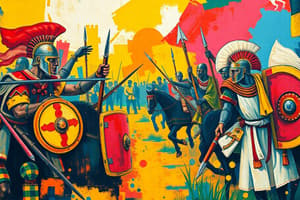Podcast
Questions and Answers
What was the primary purpose of the triremes in ancient Greek naval warfare?
What was the primary purpose of the triremes in ancient Greek naval warfare?
- To blockade enemy cities
- To launch siege engines
- To transport troops and supplies quickly (correct)
- To engage in naval battles with enemy ships
What type of warriors fought in the phalanx formation?
What type of warriors fought in the phalanx formation?
- Peltasts
- Psiloi
- Hoplites (correct)
- Cavalrymen
What tactic involved feigning retreat to lure the enemy into a trap or ambush?
What tactic involved feigning retreat to lure the enemy into a trap or ambush?
- Ambush
- Retreating (correct)
- Pincer movement
- Phalanx vs phalanx
What was the primary role of cavalry in ancient Greek warfare?
What was the primary role of cavalry in ancient Greek warfare?
What type of siege engine was used to breach city walls?
What type of siege engine was used to breach city walls?
What type of infantrymen used javelins and fought in loose formation?
What type of infantrymen used javelins and fought in loose formation?
Flashcards are hidden until you start studying
Study Notes
Ancient Greek Warfare during the Spartan War
Phalanx Formation
- A tight formation of heavily armed infantrymen
- Characterized by long spears (doru) and large shields (aspis)
- Phalanx formation provided protection and allowed for presenting a wall of spears to the enemy
Hoplite Warriors
- Heavily armored infantrymen who fought in the phalanx formation
- Equipped with:
- Doru (long spear)
- Aspis (large shield)
- Helmet
- Breastplate
- Greaves (leg armor)
- Hoplites were citizen-soldiers who fought for their city-state
Light Infantry and Cavalry
- Peltasts: lightly armored infantrymen who used javelins and fought in loose formation
- Psiloi: skirmishers who used bows and slings
- Cavalry: played a minor role in ancient Greek warfare, used for reconnaissance and pursuit
Naval Warfare
- Triremes: fast and maneuverable warships with three rows of oarsmen
- Used for rapid transportation of troops and supplies
- Naval battles involved ramming and boarding enemy ships
Siege Warfare
- Siege engines: catapults, ballistae, and towers used to breach city walls
- Mining: digging tunnels to undermine city walls
- Blockade: surrounding a city to cut off supplies and starve defenders
Tactics and Strategies
- Phalanx vs phalanx: head-on collisions between formations
- Pincer movements: outflanking the enemy to attack from multiple sides
- Ambushes: surprise attacks from hidden positions
- Retreating: feigning retreat to lure the enemy into a trap or ambush
Studying That Suits You
Use AI to generate personalized quizzes and flashcards to suit your learning preferences.




